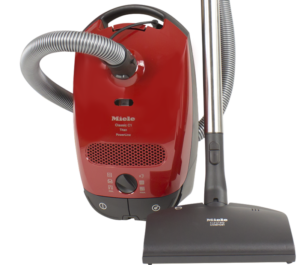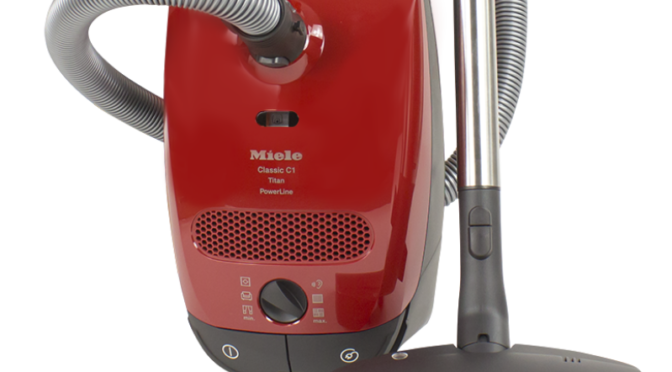
Miele has been overhauling their vacuum lines lately, with the Complete C3 series, Compact C1 series, and Compact C2 series being their current models. To tell the truth, it’s all kind of hard to keep up with. However, just because new models are released doesn’t mean the older ones do a worse job of cleaning up. Rather, it often means you can get great levels of performance for discount prices, such as with the Miele Classic C1 Titan. Today we’re going to answer some of the most frequently asked questions about the Titan and look at how it compares to the Compact C2 Electro+, which Miele describes as its replacement.
Which dust bags and filters does the Titan take for replacement, and when do you change them?
The Titan uses GN-sized dust bags and filters; Miele sells the Miele GN Airclean 3D Efficiency Dust Bag. Each box contains four dust bags, a motor filter, and an air filter. Replace the dust bags each time they fill up and the motor filter after going through each box. Skip the cheap air filter and upgrade to the Miele HEPA AirClean SF-HA 50 for HEPA filtration; it will last through 50 hours of vacuuming. We recommend buying several boxes of dust bags and filters so you don’t need to worry about rush ordering them when you’re on your last bag and filter.
How does the Titan compare to the Electro+? Which is better for carpets and hardwood floors?
The truth is that both vacuums are very similar, and the main differences come down to the design you prefer. The biggest advantage of either vacuum over most other Mieles is the fact that both come with electrobrushes and Parquet heads; the Titan uses the SEB 217-3 Powerbrush while the Electro+ uses the SEB 228 Powerbrush. Both powerbrushes are similar in performance and their abilities to clean low-pile, medium-pile, and some high-pile carpets. Both are equipped with the SBB Parquet-3 Floor Brush, which makes them equally capable of caring for hardwood floors.
The main differences, besides the fact that one is often slightly cheaper than the other, come down to the styles of the vacuums. The Titan is “normal”-sized, which means it weighs a bit more than the Electro+ but also uses larger vacuum bags and can fit its accessories inside it. The Electro+ is lighter, has a larger operating radius (33 feet vs 29.5 feet), takes smaller bags, and can’t fit all accessories inside it. Plenty of people are happy with both.
Where do you store the attachments in the Titan, and why can’t you store all of them in the Electro+?
The attachments fit in a tool caddy that you can connect to the base of the Titan’s hose; it’s a rounded disk with enough space to fit all of them. You can’t do this with the Electro+ simply because it’s smaller and designed differently; this is where the “Compact” comes in. If you want to be able to take all of your tools with you, you’ll want something in the Classic C1 line, such as the Titan, the Delphi, or the Capri.
How quiet or loud is the Titan, especially compared to the newer Miele canisters?
The Titan is a quiet vacuum, whether compared to the newer Miele vacuums in the C1, C2, and C3 lines or compared to most other vacuums on the market (against which it sounds next to silent). Like all Miele canisters, you can select the suction and power level you’d like to increase and decrease volume at will. In our books, it’s definitely quieter than Dysons, Hoovers, and most Sharks, although user experiences will naturally vary. When you want it to be extra quiet, turn it to the lowest power setting and use the non-powered Parquet brush head. Of course, that will limit you to hard surface floors instead of to carpets and area rugs, but everything comes with a compromise. You can also use the powered head without a motor if you’d like, and turn off the motor via the handle switch.
Are there any advantages to choosing the C2 or C3 lines over the C1 Titan?
The main advantages of choosing the Compact C1 and C2 lines over the Classic C1 is that these two lines include the current canisters produced by Miele, while the Classic C1 line was recently discontinued. Practically speaking, that doesn’t mean anything besides the fact that it will get harder to find Classic C1s over time. The parts are largely interchangeable across all Mieles with few exceptions–for example, you can’t plug electric brush heads into models that didn’t originally come with them. The Compact lines are going to weigh less and be easier to tote around, but the degree to which this is an advantage will depend on whether you’d find a C1 difficult to move on its own; most people we’ve come across already found it more convenient than their previous non-Miele uprights and canisters.
Compared to the C3 line, there are several things the C1s leave on the table, including a larger working radius due to a longer cord, wand, and hose. The C3 lines are also based on sealed systems, which means they’re better for families with allergies and they’re also theoretically more durable due to letting fewer contaminants inside them. The newer electric brush heads in vacuums like the Cat & Dog, the Kona, and the Soft Carpet are also slightly more advanced than those in the Classic C1s. That said, none of these differences are ground-breaking, and you can use a Classic C1 to clean any surface about as well as you would be able to with a Complete C3 while saving a lot of money.
![]() You can buy the Miele Classic C1 Titan here on Amazon. For about the same price, you can buy the Compact C2 Electro+ here. It really depends on whether you want a larger capacity vacuum or a lighter one.
You can buy the Miele Classic C1 Titan here on Amazon. For about the same price, you can buy the Compact C2 Electro+ here. It really depends on whether you want a larger capacity vacuum or a lighter one.
![]() Canadians can buy the Titan here or the Electro+ here.
Canadians can buy the Titan here or the Electro+ here.
 If you find our research on PMC helpful, you can follow our efforts to keep maniacally reviewing home cleaning tools by shopping through our links above. We promise to keep fighting the good fight against every horror children, animals, and grown, yet messy humans can inflict upon a clean home.
If you find our research on PMC helpful, you can follow our efforts to keep maniacally reviewing home cleaning tools by shopping through our links above. We promise to keep fighting the good fight against every horror children, animals, and grown, yet messy humans can inflict upon a clean home.

